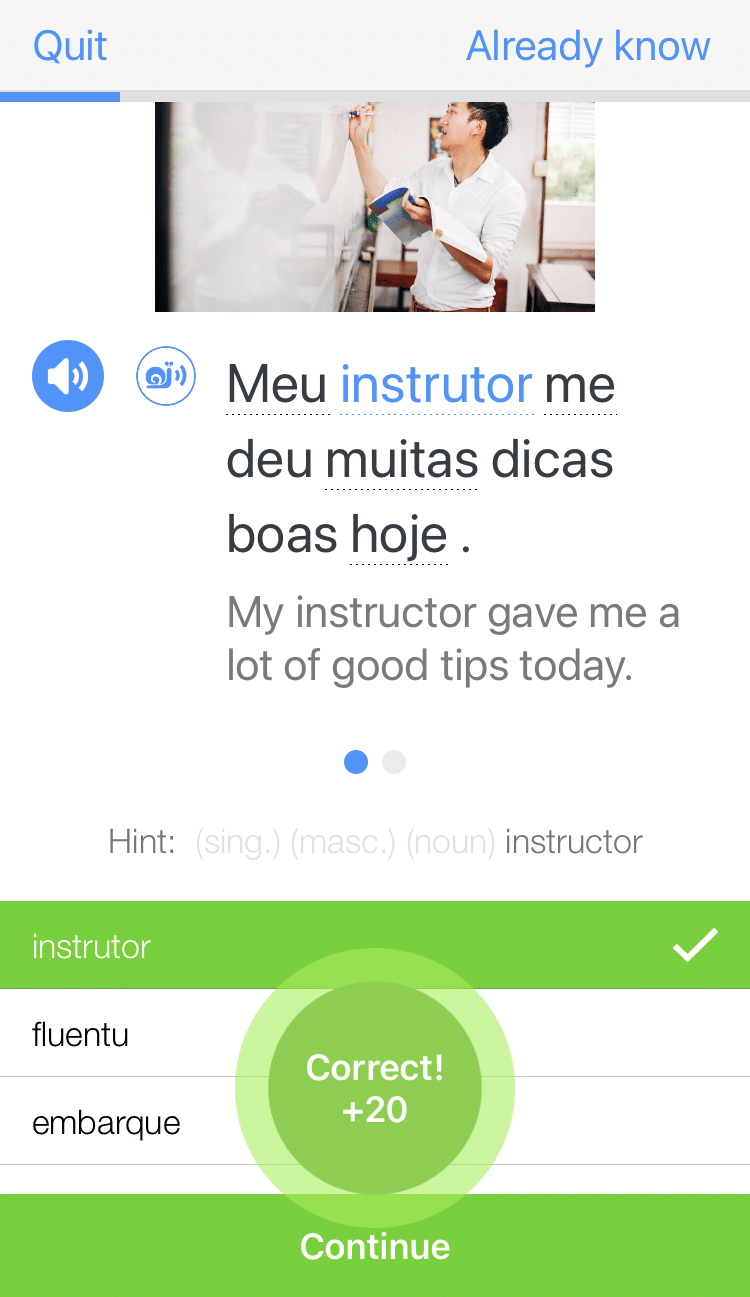50+ Common Portuguese Adjectives and How to Use Them

Using adjectives in Portuguese, or any language for that matter, will help you speak and write more descriptively. Plus, being familiar with some of the most common Portuguese adjectives will greatly improve your comprehension.
There are a few basic differences between Portuguese and English adjectives, like the use of gender and their placement in a sentence. In this guide, you’ll learn more than 50 frequently used adjectives in Portuguese and how to use them correctly.
Download: This blog post is available as a convenient and portable PDF that you can take anywhere. Click here to get a copy. (Download)
Common Portuguese Adjectives
Here are some of the most common Portuguese adjectives to get you started:
| Portuguese | English |
|---|---|
| feliz | happy |
| triste | sad |
| jovem | young |
| velho | old |
| novo | new |
| lindo | pretty |
| belo | beautiful |
| feio | ugly |
| alto | tall |
| baixo | short |
| grande | large |
| pequeno | small |
| inteligente | smart |
| magro | thin |
| gordo | fat |
| frio | cold |
| quente | hot |
| bom | good |
| horrível | horrible |
| ruim | awful |
| rápido | fast |
| lento | slow |
| forte | strong |
| fraco | weak |
| rico | rich |
| pobre | poor |
| alegre | joyful |
| engraçado | funny |
| amigo | friendly |
| irritado | irritated |
| limpo | clean |
| sujo | dirty |
| doce | sweet |
| azedo | sour |
| duro | hard |
| macio | soft |
| liso | smooth |
| áspero | rough |
| cheiroso | fragrant |
| fedorento | smelly |
| claro | light |
| escuro | dark |
| saboroso | tasty |
| insípido | tasteless |
| maduro | ripe |
| branco | white |
| preto | black |
| vermelho | red |
| azul | blue |
| verde | green |
| amarelo | yellow |
Try making your own sentences using these words and the rules you’ll learn in this post! You can also build your adjective vocabulary with pre-made digital flashcards.
Portuguese Adjective Placement
In English, the adjective proceeds the noun. But in Portuguese, the adjective usually goes after the noun. So instead of saying, “the fat cat is sleeping,” you’d say, o gato gordo está dormindo (Lit.: “the cat fat is sleeping”).
Here are a couple more examples:
a pessoa engraçada
— the funny person
um vestido lindo
— a beautiful dress
There are, however, some times when the adjective is placed right before the noun, usually when the adjective describes an intrinsic quality. Whether the adjective goes before or after the noun can actually change its meaning:
Ele é um homem grande.
(He’s a big man. — describes his body size)
Ele é um grande homem.
(He’s a great man. — refers to his intrinsic qualities as a person)
This video explains the proper position of Portuguese adjectives in more depth:
Matching Adjective Gender
The Portuguese language matches the gender of the adjective to the gender of the noun.
If the noun is masculine (usually ending in the letter o), then the adjective will probably end in an -o. If the noun is feminine (usually ending in the letter a), then the adjective will probably end in an -a.
Ele é alto.
(He’s tall.)
Ela é alta.
(She’s tall.)
O carro é amarelo.
(The car is yellow.)
A casa é amarela.
(The house is yellow.)
Some nouns don’t end in either -o or -a, so you’ll have to memorize the gender of those nouns. You can do this by memorizing the article along with the noun. For example, learn o refrigerador (the refrigerator) and the article o (the) will remind you that the word is masculine.
So what do you do when an adjective ends in an -e, -l or -r? Well, you just tack it on how it is—no need to change anything!
A prova foi fácil.
(The test was easy.)
O cachorro marrom
(The brown dog)
Pluralizing Portuguese Adjectives
Plural endings are easy: All you have to do is put an -s at the end of the adjective.
As calças baratas
(The cheap pants)
Comprei brinquedos divertidos.
(I bought fun toys.)
However, there are some adjectives that act irregularly when they’re made plural. These are usually the adjectives that don’t end in just -o or -a. Here are a few examples:
azul (blue) → azuis
fácil (easy) → fáceis
mau (bad) → maus
(masculine), más
(feminine)
Using Diminutive and Augmentative Adjectives
Often, people will add a diminutive or augmentative to the end of an adjective. The diminutive means you’re making something seem cutesy or just saying it’s a little bit of something.
For example, É rosinha means “It’s a bit pink.” The augmentative means something is a more extreme version of the adjective.
Basically, to create a diminutive, you replace the -o or the -a at the end of the adjective with -inho or -inha. To create an augmentative, you add -íssimo or -íssima at the end, instead. For example:
Bonito (pretty) in the diminutive is bonitinho, which translates literally as “little pretty” but has the connotation of “super cute.”
Agradável (pleasant/enjoyable) in the augmentative is agradabilíssimo, which means “very enjoyable.”
Adding Modifiers Before Adjectives
Another way to indicate the augmentative is using the word “very,” which in Portuguese is either muito or bem. When using these words, place them before the adjective:
A noite é bem fria.
(The night is very cold.)
O céu é muito bonito.
(The sky is very pretty.)
You can also use modifiers like mais (more/most) and menos (less/least). For example:
o mais bonito de todos
(the prettiest of all)
o menos perigoso
(the least dangerous)
How to Learn Portuguese Adjectives
One of the best ways to memorize these adjective rules isn’t only through practice but also through exposure. With that in mind, here are some of the best ways to learn Portuguese adjectives:
- Record yourself. Speaking out loud can help you get accustomed to actually using the words. Use recording software when you practice so you can play your own words back and check for pronunciation problems and other issues. If you learn best by listening, record yourself saying the rules themselves, along with some examples.
- Write it down. If you’re a visual or tactile learner, writing down adjectives in a sentence (practicing the gender and placement, as well as irregularities) can help you remember these rules better when you’re speaking. So pull out a notebook and pen and jot down some examples!
- Use flashcards. You can go old school and use paper flashcards or you can use a flashcard app to help you remember the rules of Portuguese adjectives. Try writing down a sentence in English on one side with the Portuguese translation on the other. Then test yourself to see if you can translate the English into Portuguese while following the Portuguese adjective rules.
- Download an app. There are plenty of apps out there to help you learn Portuguese and many of them include adjective rules and vocabulary to help you learn. Some will even have you create simple sentences and quiz you on your understanding. Remember to search around for the best option for you, because not all apps are created equal.
- Put up sticky notes. If you learn best by associating words with images, try using sticky notes to write down a few nouns and adjectives for each of the rules. For example, if you have two blue couches, put “as sofás azuis” (the blue couches) on a sticky note and attach it to a couch. Then, when you see the sticky note, you’ll be reminded of how to form irregular plural adjectives.
- Watch videos. When you watch real-world videos of people and hear how they use the language, you get a much better understanding of it—including these tricky Portuguese adjective rules. For example, you can see native speakers using adjectives naturally through Portuguese media clips on FluentU.
FluentU takes authentic videos—like music videos, movie trailers, news and inspiring talks—and turns them into personalized language learning lessons.
You can try FluentU for free for 2 weeks. Click here to check out the website or download the iOS app or Android app.
You can also find lots of helpful resources and videos on YouTube, like this one:
Now all you have to do is put these rules into practice!
With some effort and time, Portuguese adjectives will become second nature for you.
Download: This blog post is available as a convenient and portable PDF that you can take anywhere. Click here to get a copy. (Download)
And One More Thing...
If you're like me and enjoy learning Portuguese through movies and other media, you should check out FluentU. With FluentU, you can turn any subtitled content on YouTube or Netflix into an engaging language lesson.
I also love that FluentU has a huge library of videos picked specifically for Portuguese learners. No more searching for good content—it's all in one place!

One of my favorite features is the interactive captions. You can tap on any word to see an image, definition, and examples, which makes it so much easier to understand and remember.
And if you're worried about forgetting new words, FluentU has you covered. You'll complete fun exercises to reinforce vocabulary and be reminded when it’s time to review, so you actually retain what you’ve learned.
You can use FluentU on your computer or tablet, or download the app from the App Store or Google Play. Click here to take advantage of our current sale! (Expires at the end of this month.)










